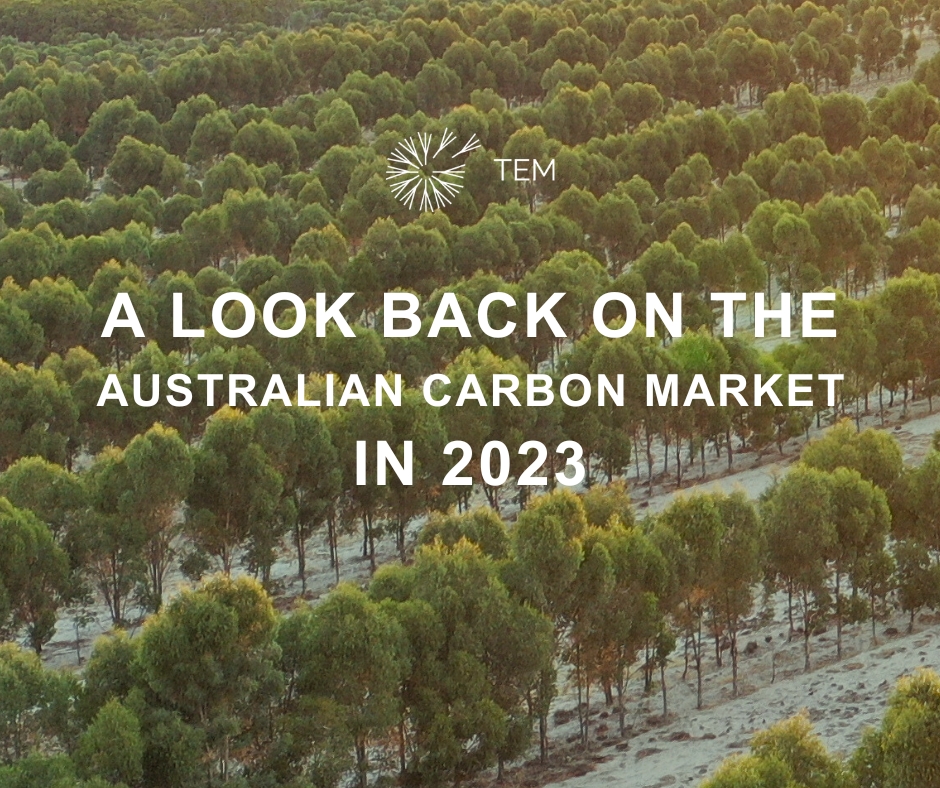A look back on the Australian carbon market in 2023

With the end of the year almost here, TEM’s Head of Carbon Solutions, Bjorn Everts, shares some key insights on the year that was for the Australian carbon market.
The Australian carbon credit market has witnessed a transformative journey in 2023, characterised by a blend of regulatory changes, increased methodological scrutiny alongside and overall increase in and broadening participation from a diverse range of sectors.
Rising ACCU demand and regulatory changes
The evolution of Australia’s carbon market in 2023 has been primarily driven by the implementation of the Safeguard Mechanism (Crediting) Amendment Act 2023. Effective from July 1, 2023, these reforms notably influenced the Australian Carbon Credit Unit (ACCU) market by placing around 220 of Australia’s major industrial facilities on a path to net zero emissions, requiring them to reduce greenhouse gas emissions by an average of 4.9% annually until at least 2030. Facilities exceeding their emission baselines under this Mechanism face a financial penalty, or they can opt to offset their excess emissions with ACCUs. This regulatory change has spurred a significant increase in ACCU demand as safeguard affected facilities look to take a position in the market to manage forward price and supply risk.
Total demand from safeguard affected entities is projected to grow from approximately 7 million tonnes in 2023-24 to around 20 million tonnes by 2025-26, with demand potentially surpassing supply in 2028.[1] This trend aligns with the Australian Government’s goal to cut emissions by 43% by 2030 and to continue towards net zero emissions by 2050. Consequently, these reforms have repositioned the ACCU market to better align with Australia’s environmental objectives, affecting market prices, stimulating ACCU demand, and enforcing stricter emissions reduction standards on major industrial sectors.
A vote of confidence following Chubb Review
The Chubb Review’s outcome has been a cornerstone in the journey of Australia’s carbon credit system this year, impacting the ACCU market in several ways. Firstly, it has reinforced the ACCU market’s position as a significant and credible player in the global offsetting arena, as the Review found that Australia’s carbon credit market is fundamentally credible and robust. The bipartisan acceptance of the findings of the Chubb Review affirmed the ACCU scheme’s fundamental soundness, acknowledging its successful operation over a decade, while also highlighting the necessity for ongoing improvements.
One of the key recommendations from the Chubb Review was the further enhancement of the scheme’s integrity and governance. It proposed the establishment of a more independent Carbon Abatement Integrity Committee with a full-time Chair, aimed at replacing the existing Emissions Reduction Assurance Committee. This move is intended to strengthen the framework’s credibility and effectiveness.
Furthermore, the conclusion of the Chubb Review was met with strong positive pricing expectations for Australian offsets, driven by increasing demand from Australian corporations for credible carbon offsets. This anticipated growth in demand, coupled with the review’s endorsement of the ACCU market’s structure and potential for further development, suggests a strong and dynamic future for the market with independent analysts agreeing on the positive upward trend of ACCU pricing especially as existing supply is absorbed in the next 12 months by a mix of compliance buyers and organisation’s firming up their 2030 targets.
Market dynamics: pricing and supply
What’s been happening?
In 2023, the ACCU market experienced significant changes in both pricing and supply. The demand for ACCUs rose, driven by the Safeguard Mechanism. This increase in demand was evidenced by a record trading volume of 13 million ACCUs in the first quarter of 2023. However, the spot generic ACCU price softened down to $32 after a sitting at $38 at the beginning of the year.
There has been a significant stratification in the market with Indigenous savanna burning carbon credits trading higher than $50 and environmental planting ACCUs trading above $75 per ACCU. This is largely driven by demand for quality and integrity, as well as the additional cultural and environmental outcomes offered by these units and their relatively constrained supply.
What’s next?
In terms of supply, there is an expectation of ACCU availability up to 2028, with around 24 million ACCUs in the Australian National Registry of Emissions Units as of Q1 2023, and a projection to issue over 18 million ACCUs in the same .[2] However, demand is expected to match supply as the Safeguard baselines continue to ratchet down. TEM is already seeing a substantial increase in Safeguard-affected companies wanting to build substantial ACCU portfolios to meet near and long-term demand.
TEM has also seen an increase in demand for forward contracts, with companies looking to secure supply for five, ten and even fifteen years into the future from high-quality human-induced regeneration and environmental planting projects. TEM is also experiencing a marked increase in demand for project development services and partnerships where Safeguard-affected companies are wanting to take control and ownership of their ACCU supply by developing their own projects and owning the land on which the projects are developed. This is demand for project development is often accompanied by requests to include additional biodiversity components and considerations as a way of increasing the ESG-related value of the projects.
The role of international offsets
The Australian Government’s Climate Change Minister, Chris Bowen, has indicated a delay of several years before integrating international credits into the reformed Safeguard Mechanism’s emissions scheme. However, in 2023, the Australian voluntary carbon market, influenced by corporate net-zero targets, exhibits a strong continued demand for international offsets.
Despite no regulatory mandate aligning corporate emissions reductions with national goals, investor and customer pressures push companies towards net zero, leading them to predominantly source carbon credits from lower-cost international projects, notably in Asia. It is important to note that whilst the governance standards for international offsets differ from those presiding over the ACCU market, international offsets can be developed under the most rigorous guidelines. This is becoming increasingly prevalent as media scrutiny tightens on the governance and financial management underpinning international offsets.
Exciting developments at COP28 also point to the operationalisation of Article 6 of the Paris Agreement, which would see the development of a scaled-up high-integrity global carbon market that would facilitate the trade of carbon credits between nation states. This will be particularly important for nature conservation and regeneration in less economically developed countries seeking to make the most of their natural capital. The operationalisation of Article 6 is likely to create a significant boost to the international carbon market by increasing integrity and quality whilst also creating a substantial driver for global demand.
Intermediaries, such as TEM, which have robust due diligence processes to ensure they only offer high-quality offsetting solutions, are increasingly being sought to help identify and develop high quality international carbon projects for both the Australian market and the growing demand in the Asia Pacific Region.
Wrap up
This year the Australian carbon credit market has undergone significant changes, especially in the ACCU sector. Key developments include the implementation of the Safeguard Mechanism, leading to a marked increase in ACCU demand as industries strive to meet stricter emissions reduction targets. The Chubb Review has further solidified the market’s credibility, recommending enhancements in governance to bolster its integrity.
Market dynamics have shifted with rising demand and evolving pricing, notably in specific ACCU categories like Indigenous savanna burning and environmental planting credits. The supply side is also adapting, with an increase in forward contracts and a focus on project development. While the integration of international offsets into the emissions scheme has been delayed, the voluntary carbon market shows a strong preference for these offsets, driven by corporate net-zero targets and evolving governance standards. These developments collectively indicate a robust and dynamic future for Australia’s carbon market, aligning it more closely with the country’s ambitious environmental objectives.
Reference list:
[1] S&P Global: Australia’s carbon credit demand to surpass issuances in 2028 as compliance tightens: https://www.spglobal.com/commodityinsights/en/market-insights/latest-news/energy-transition/113023-australias-carbon-credit-demand-to-surpass-issuances-in-2028-as-compliance-tightens
[2] Clean Energy Regulator: https://www.cleanenergyregulator.gov.au/Infohub/Markets/Pages/qcmr/march-quarter-2023/Australian-Carbon-Credit-Units.aspx
Disclaimer
This information has been prepared by Tasman Environmental Markets Australia Pty Ltd (TEM), a corporate authorised representative (ABN 97 659 245 011, CAR 001297708) of TEM Financial Services Pty Limited (ABN 58 142 268 479, AFSL 430036). It provides general advice only and does not constitute personal financial advice or take into account your objectives, financial situation or needs. Although we believe that the material is correct, no warranty of accuracy, reliability or completeness is given, except for liability under statute which can’t be excluded. Before making an investment decision, you should first consider if the information is appropriate for your circumstances, and seek professional financial advice. Please note past performance is not a guarantee of future performance.



